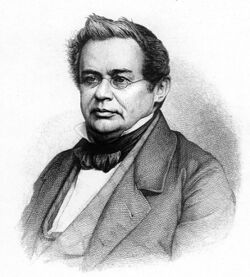Biography:Emil Lenz
Emil Lenz | |
|---|---|
 | |
| Born | Dorpat, Governorate of Livonia, Russian Empire |
| Died | 10 February 1865 (aged 60) Rome, Papal States |
| Alma mater | University of Tartu |
| Known for | Lenz's law |
Heinrich Friedrich Emil Lenz (/lɛnts/; German: [lɛnts]; also Emil Khristianovich Lenz, Russian: Эмилий Христианович Ленц; 12 February 1804 – 10 February 1865), usually cited as Emil Lenz,[1][2] was a Russian physicist. He is most noted for formulating Lenz's law in electrodynamics in 1834.[3]
Biography
Lenz was born in Dorpat (nowadays Tartu, Estonia), at that time in the Governorate of Livonia in the Russian Empire. After completing his secondary education in 1820, Lenz studied chemistry and physics at the University of Dorpat.[2] He traveled with the navigator Otto von Kotzebue on his third expedition around the world from 1823 to 1826. On the voyage Lenz studied climatic conditions and the physical properties of seawater. The results have been published in "Memoirs of the St. Petersburg Academy of Sciences" (1831).
After the voyage, Lenz began working at the University of St. Petersburg, Russia, where he later served as the Dean of Mathematics and Physics from 1840 to 1863 and was Rector from 1863 until his death in 1865. Lenz also taught at the Petrischule in 1830 and 1831, and at the Mikhailovskaya Artillery Academy.
Lenz had begun studying electromagnetism in 1831. Besides the law named in his honor, Lenz also independently discovered Joule's law in 1842; to honor his efforts on the problem, it is also given the name the "Joule–Lenz law," named also for James Prescott Joule.
Lenz eagerly participated in development of the electroplating technology, invented by his friend and colleague Moritz von Jacobi. In 1839, Lenz produced several medallions using electrotyping. Along with the electrotyped relief produced by Jacobi the same year, these were the first instances of galvanoplastic sculpture.[4]
Lenz died in Rome, after suffering from a stroke.
A small lunar crater on the far side of the moon is named after him.
See also
- List of Baltic German scientists
References
- ↑ I. Grattan-Guinness (ed.), Companion Encyclopedia of the History and Philosophy of the Mathematical Sciences, Volume 2, Johns Hopkins University Press, 2003, p. 1213.
- ↑ 2.0 2.1 Lezhneva, Olga (1970–1980). "Lenz, Emil Khristianovich (Heinrich Fridrich Emil)". Dictionary of Scientific Biography. 8. New York: Charles Scribner's Sons. pp. 187–189. ISBN 978-0-684-10114-9.
- ↑ Lenz, E. (1834), "Ueber die Bestimmung der Richtung der durch elektodynamische Vertheilung erregten galvanischen Ströme", Annalen der Physik und Chemie, 107 (31), pp. 483–494. A partial translation of the paper is available in Magie, W. M. (1963), A Source Book in Physics, Harvard: Cambridge MA, pp. 511–513.
- ↑ History of electroplating in the 19th century Russia. (in Russian)
External links
- Page on Lenz from a list of famous electroscientists
- Biography of Lenz[|permanent dead link|dead link}}]

